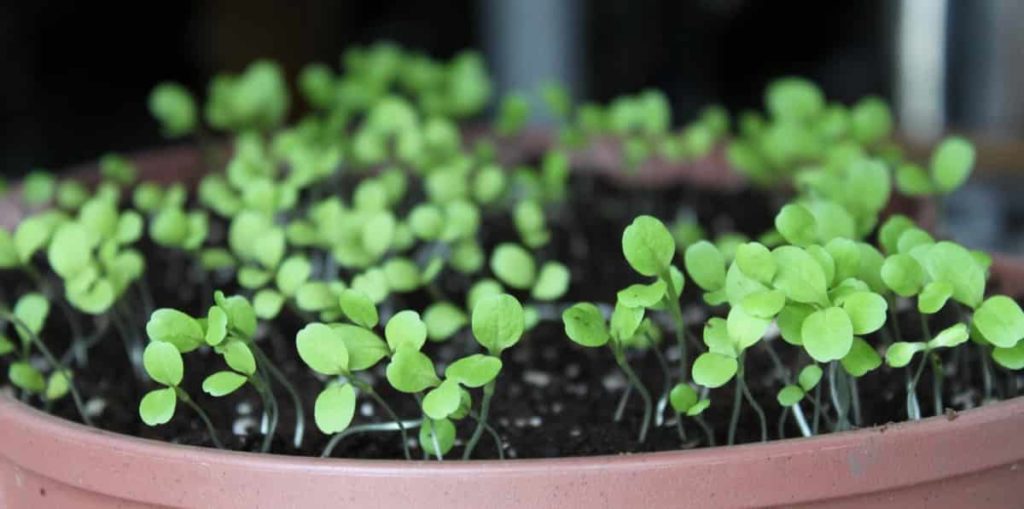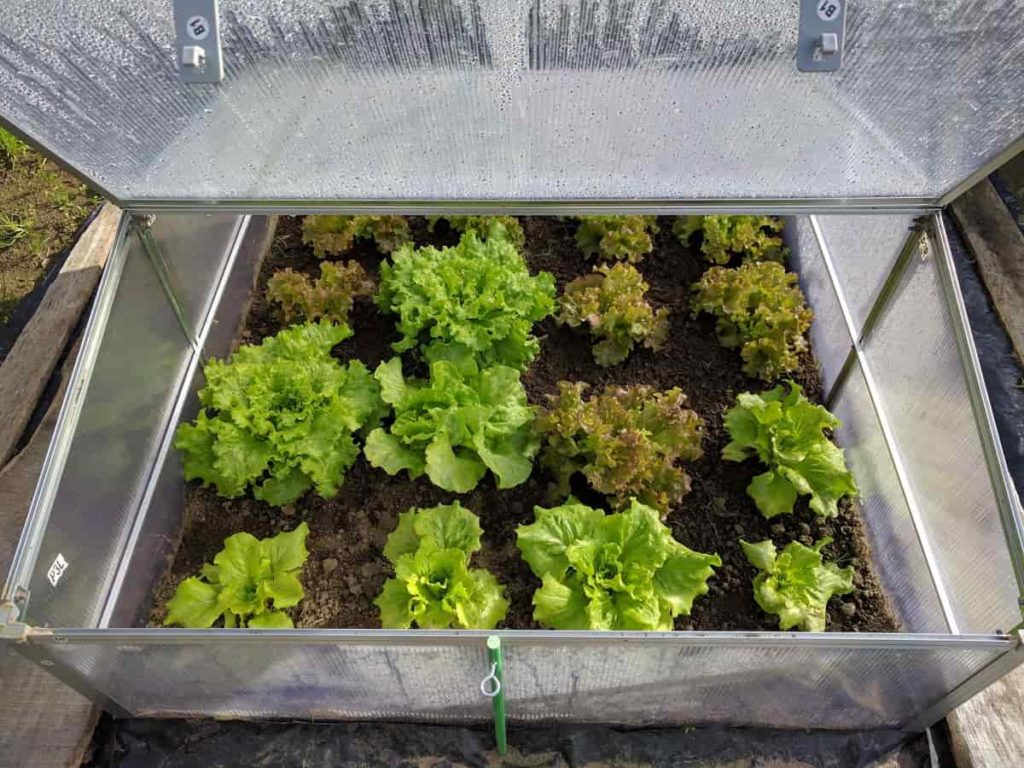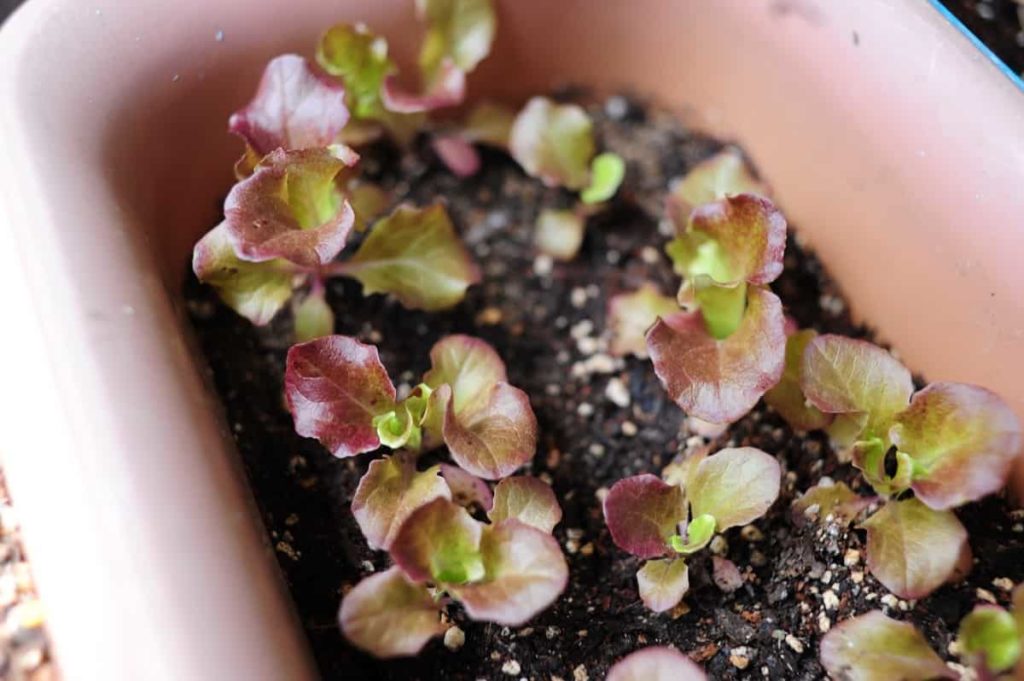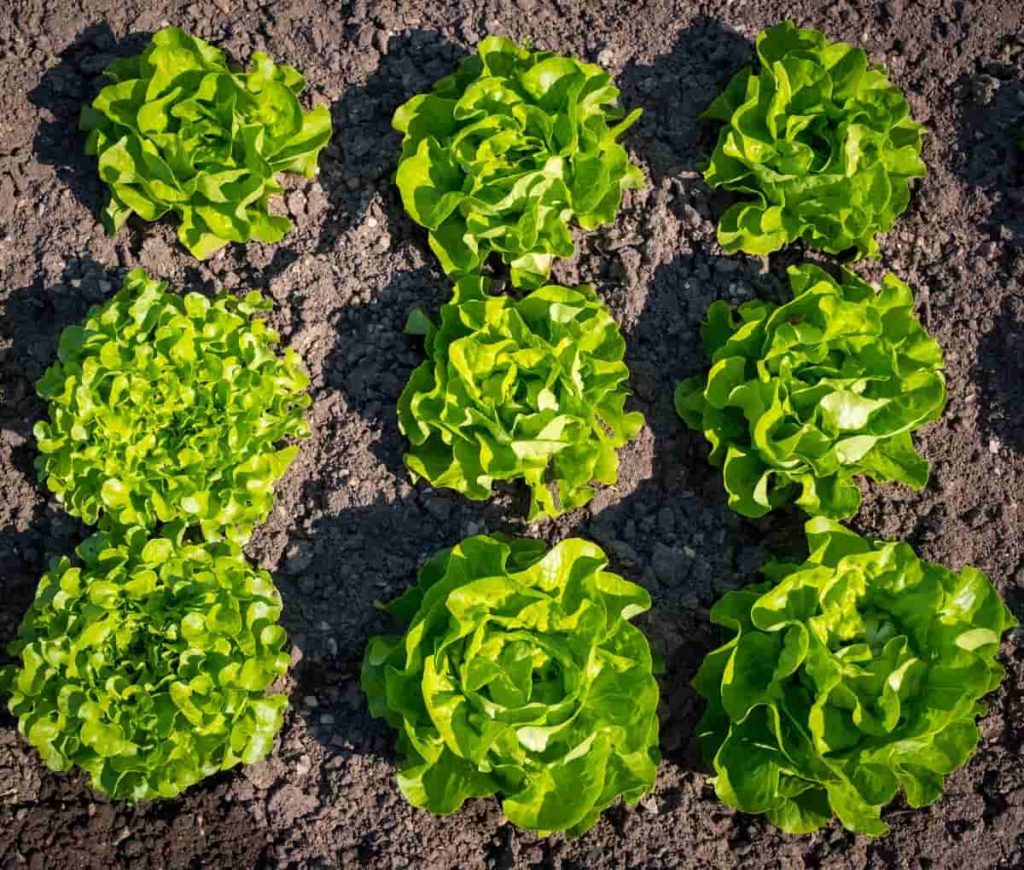Lettuce can be grown on a wide range of soils, but fertile sandy loam works best on soil with organic matter. While the Lettuce needs plenty of moisture, you should avoid areas with soggy soil and poor drainage. Lettuce is a great candidate to grow in raised beds or containers. Ideally, the Lettuce grown for seed is grown in fertile, well-drained soil to minimize disease problems. If drainage is good, heavy soils such as clay loam and silt are preferred, as they can better maintain moisture and nutrients during the growing season.

Successful production of Lettuce depends on strong growth. Adequate nutrients and continuous moisture supply are essential for vigorous growth. Soil testing determines the quantity of lime and manure required, and soil samples should be taken long before preparing the ground. Preparing for the right field before planting seeds or transplanting young seedlings is important. Let’s check out how to prepare the soil for Lettuce plants.
Farmers report that it is helpful up to soil and usually apply compost or well rotten manure a week before transplanting or planting direct seeds. However, the poor soil conditions do not help the plant cope with the hot temperature when the soil does not place proper moisture around the roots. Soil modification will help prevent most problems, but sometimes, choosing the wrong fertilizer for soil can lead to nutrient deficiencies or problems.
How to prepare the soil for Lettuce plants
Soil pH for Lettuce
While Lettuce plants are not picky about the soil consistency, sandy loam soil with a loose consistency and plenty of organic matter best serves this leafy vegetable. The Lettuce is like well-drained soil that remains moist but never full of water. This plant’s soil should have a pH range of 6.0 to 6.7. The Lettuce doesn’t like very acidic soil; it should be almost neutral from a little acidic, about 6.2 to 6.8.
It loves soil that has been modified with compost and manure. Soil should have the proper level of calcium to prevent tip burn. And the soil should remain equally moist. If your plants are not growing in your soil conditions due to too much alkalinity, you may need to know more about increasing acid levels in soil pH. The easiest way to make the soil more acidic is to add sphagnum peat moss.
It works especially well in small garden areas. First, add one or two inches of peat to the topsoil only in and around plants or during planting. Then, water plants several times two tablespoons with a gallon of vinegar-water solution. It is a great way to adjust pH in container plants. Acidifying fertilizers can also be used to help increase acidity levels. Ammonium sulfate and sulfur-coated urea are good choices to make the soil acidic.
In case you missed it: 16 Common Lettuce Plant Problems: How to Fix Them, Solutions, and Treatment

Ammonium sulfate can easily burn plants if not used carefully. For this reason, you should always read and follow the label instructions carefully. Sulfur is slow-acting, takes several months, and is more commonly used by large-scale farmers rather than home gardeners. Granular sulfur is considered safe and effective for small garden areas, with no more than 950 grams per 100 square feet.
Preparation of soil growing Lettuce in pots
To get the best yield from homegrown plants, you need to ensure that the potting mix you use to plant seeds is rich in essential nutrients. Always try to get a pH level of 6.0 to 7.0 for soil. An ideal potting mix should be a perfect combination of fertile soil and vermicompost. If you are sown Lettuce in pots, you can make potting mix by mixing equal parts of any natural fertilizer, such as dry leaves or grass, food scraps, etc., with perlite.
Special potting soil is looser and better at maintaining water than regular garden soil. Regular garden soil will often pack firmly with each other and deprive the roots of their oxygen. It’s also easy to make your potting soil at home. One part perlite, vermiculite, and one part compost.
Preparation of soil for growing Lettuce on grounds
The addition of compost or manure, will provide essential nutrients and improve the growing conditions of your Lettuce. It is easy to grow Lettuce in any good garden soil. Add 2 to 3 inches of garden compost or manure to the bed at the planting time. If you’re not using manure for really luxurious growth, you can add an organic nitrogen source at planting. Choose fast-running organic nitrogen fertilizers such as worm casting, composted chicken manure, bat guano, blood meal, or fish meal in cold weather.
The Lettuce needs well-drained soil with loads of organic matter (such as the crumbly compost), a bit of seaweed feed, and some mulch. The new seedlings will benefit when the soil is prepared about two weeks before planting. Do this through light working compost and a little pelletized fertilizer through the soil, followed by mulch. Lettuces are a heavy feeder as they grow pretty quickly and produce a lot of leaves per plant.
They need to grow faster for the best taste and shape. Large quantities of commercial liquid fertilizers on the Lettuce seedlings will encourage development, but it also encourages the hordes of snails who feast on the soft Lettuce growth. If you want to feed, use compost or manure tea to do it for a fortnight, half a day. You can also provide a half-strength seaweed solution at the planting time, as it is great for encouraging strong root development.
In case you missed it: Top 14 Lettuce Companion Plants, Planting Guide

How to grow Lettuce in poor soil
If your garden contains poor soil, you have to make a raised bed, fill it with a mixture of manure and compost, or select a container to plant Lettuce. Prepare the garden bed as soon as you can do the work on the ground by removing the debris of all the weeds and leftover plants. Next, add about 2 inches of aged manure to your soil and work it at a 6 to 8 inches depth. When you work as a soil, remove a stone and a twig and break large clumps of soil.
Soil composting for Lettuce
You can improve any soil with soil amendments. You can enhance heavy soil or sandy soil Heavy soil by adding organic materials like compost, manure, or leaf mold. The texture is an important consideration when choosing an amendment. An amendment that is grainy and finely grained is essential for container mix. For gardens, coarse grain amendments can improve drainage and air. The Lettuce works best in loose, well-drained soil, which regularly contains water and proper nitrogen.
Whether your soil is heavy soil or light sandy type, the incorporation of compost will improve the often-growing conditions. Homemade compost is ideal, with municipal compost made from green waste recycling being the next best. As per fertilizer label recommendations, add nitrogen fertilizer before planting, where transplants will be done. Good organic nitrogen sources include alfalfa, cottonseed, fish and kelp, and blood and feather meals.
Land preparation for Lettuce
Soil preparation for the seeds of the Lettuce should follow the same methods as the production of the head of the Lettuce. Soil should be loosened to 12 inches using a plow, tiller, or spader. The Lettuce roots are very thin and delicate, spread over a very small area, and are thus very sensitive to drying. Therefore, the soil should be thoroughly cultivated and drained considerably, but water should be allowed to be maintained well.
In case you missed it: Lettuce Planting Questions and Answers (FAQs)

You should give the Lettuce space to accommodate light mechanical tillage. The spacing will vary according to the size required and the type of Lettuce grown. If you are not planting on beds, use a close distance within the row and leave a gap between the rows to accommodate the implementation of cultivating if necessary.
Best soil mix for Lettuce
Lettuce needs nitrogen in its soil to perform well, and you can do it by combining a lot of organic matter. Some options are compost, rotten manure, or leaf molds. Soil mixtures that are 20-50% organic matter work best for potted plants, as they prevent the soil from drying fast. To make a 20% organic matter mixture, mix four soil containers with one container of organic matter, like compost. Soil mixture is usually vermiculite or perlite, compost, and soil for water retention.
Natural soil amendments for Lettuce
The Lettuce also needs good, loose, rich soil to grow well. Soil which is well modified with compost or rotten manure is ideal. Soil with lots of organic matter maintains moisture better, which is very important in keeping these shallow root vegetables happy. The best time to prepare the soil for the spring plantation season is the previous fall season, so organic materials have time to decompose and are part of your soil.
Waiting for a while to plant after modifying your soil with specific fertilizers like chicken manure or fresh manure will also ensure that your plants do not burn with excess nitrogen in the fertilizer. Adding blood meal to garden soil will help increase nitrogen levels and help plants become lush and greener. Nitrogen in blood meal can also help increase your soil acid levels, which is beneficial for certain plants that prefer low pH soil. Get your soil tested before adding bone meal for plants to your garden.
If you find out that your soil has more than pH 7, correct your soil pH first before adding bone meal; otherwise, bone meal will not work. You should increase the amount of potassium by adding wood ash to your compost pile. You can also use manure, which contains a small percentage of potassium and is relatively easy on plant roots. The kelp and Greensand are also good sources of potash. It is wise to test the soil before using potash in the garden to see if your soil is deficient in potassium.
In case you missed it: Growing Lettuce Indoors – A Planting Guide For Beginners

What to do with soil when growing Lettuce
Avoid growing the Lettuce near Broccoli, Brussels Sprouts, Cabbage, Cauliflower, Kale, or Kohlrabi. In contrast, some types of Lettuce can help grow these cabbage family crops, plants that contain special root secretions that can prevent the germination of Lettuce seeds. Fennel is a garden crop that doesn’t play well with most other vegetable plants, so it’s not recommended for most home gardeners.
While it may attract beneficial insects, it can serve as an inhibitor for the growth of most other plants stunting them or even killing them completely. Therefore, when growing Asparagus, you should leave a small portion of the crop to keep growing in your garden to allow the plant to store energy for next year. These leftover Asparagus plants will grow taller and spread leaves which are a great source of natural shade if your Lettuce plants are getting too much sunshine in the afternoon and starting to wither.
Beetroot is a root crop, which means they use underground space to grow their produce, while the roots of the Lettuce plants are very shallow, and they grow their crop over the soil. You can plant Beetroot and Lettuce very close together as they do not compete for the same area. Plant Calendula away from your Lettuce rows to attract slugs away from your Lettuce. As a root crop, Carrots use underground space to grow their produce, while the roots of the Lettuce plants are very shallow, and they grow their crop over the soil.
Aromatic herbs do a great job removing pesky insects and attracting the beneficial. Plant aromatic Coriander near your Lettuce to stop the insects. Eggplant is a summer crop, thriving in weather conditions that will be too hot for healthy Lettuce; plant an Eggplant near your growing Lettuce so it can occupy space after your Lettuce is harvested. Garlic can act as a barrier plant against aphids. Plant garlic between your Lettuce crop rows to prevent your Lettuce from aphids.
In case you missed it: Growing Organic Lettuce – A Full Guide

The aroma of various Mint plants will repel the slug, which is a dangerous pest to the Lettuce. Nasturtiums are beautiful flowers that attract aphids. While this may seem contradictory, many gardeners plant Nasturtiums a short distance from their vegetable garden to attract aphids away from their crops. As a root crop, alliums like Onions and Shallot use underground space to increase their production, while the roots of the Lettuce plants are very shallow, and they grow their crop over the soil.
As a root crop, Parsnips use underground space to grow their produce, while the roots of the Lettuce plants are very shallow, and they grow their crop over the soil. Therefore, fast-growers like Radish can help you mark the rows of slow-growing Lettuce; plant a few Radish seeds along with the Lettuce, and the Radish will grow faster, showing where the Lettuce line is eventually growing.
At the same time, the Lettuce can improve the Radish crop, making them softer and more delicious in summer. Turnips naturally repel the aphids, which can cause severe damage to the Lettuce leaves. Plant the Turnips near the Lettuce to prevent the aphids from your Lettuce.
- Where to Place Indoor Plants in Your Home
- How to Grow Tomatoes Organically at Home: A Comprehensive Guide
- Organic Gardening on a Budget: Low-Cost Methods and Materials
- Gongura Seed Germination and Planting Methods
- Cabbage Seed Germination and Selection
- Broccoli Seed Germination and Selection
- Asparagus Seed Germination and Variety Selection
- Seasonal Flower Gardening: Best Practices for Spring, Summer, Fall, and Winter
- How to Grow Hibiscus from Flower
- Plantation Ideas for Home Decoration: A Beginners Guide
- Flower Garden Designs and Layouts for Beginners
- Planting and Spacing Techniques in Papaya: A Beginner’s Guide
- Growing Gold: Essential Techniques for Planting Pineapples
- How to Make Kalanchoe Plant Bushy: Home Remedies and Solutions
- 11 Reasons Why Your Gardenia is Not Blooming: Home Remedies and Solutions
- Eco Elegance: The Guide to Designing a Drought-Tolerant Landscape
- Gardening on a Slope: Strategies for Hillside Landscaping
- Nourish and Flourish: Top Organic Mulches for Thriving House Plants
- Everything You Want to Know about Indian Mogra Flower: Discover Uses and Growing
- Green Thumb Success: Expert Tips for Cultivating Greenhouse Pumpkins All Year Round
- Maximize Growth & Flavor: The Ultimate Guide to Companion Planting in Herb Gardens
- How to Control Rhododendron Problems Naturally: Home Remedies and Organic Ways to Fix Them
- Natural Magic: The Remarkable Benefits of Cinnamon for Plants
- Best Steps to Revive Dying Tulip with Natural and Organic Treatment
- 10 Reasons Why Your Angel Trumpet is Not Blooming: Remedies and Treatment
- How to Fix Periwinkle Leaf and Flower-Related Problems: Natural Remedies and Solutions
- How to Fix Zinnias Leaf and Flower Problems: Discover Natural and Home Remedies
- Organic Steps to Induce Lemon Tree Flowers: A Comprehensive Guide
- Bloom Booster: Crafting the Perfect Homemade Bougainvillea Fertilizer
- Optimizing Growth: A Guide to Applying NPK Fertilizer for Potted Plants
- 10 Best Homemade Fertilizers for Rubber Plant: DIY Recipes and Application Method
- How to Boost Female Pumpkin Flowers: Effective Steps for More Flowers and High Yields
- Transform Your Indoor Garden: Top Benefits of Pink Salt for Houseplants
- 10 Best Homemade Fertilizers for Peacock Plants (Calathea): Easy DIY Guide
- Unlock Blooms: 9 Reasons Why Your Potted Chrysanthemum is Not Blooming
- 8 Reasons Why Your Potted Hibiscus is Not Blooming: Fix it with Simple Solutions